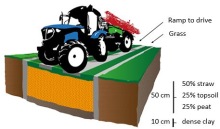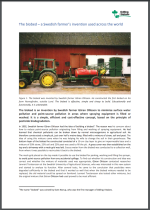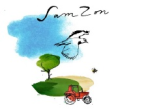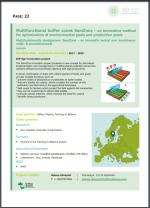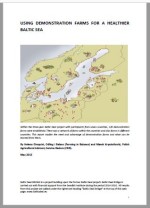Farming in Balance
"Odling i balans" (➜ www.odlingibalans.com) means "Farming in Balance" and is the name of a Swedish network of 18 pilot farms that was founded 30 years ago to focus on balanced agriculture. Farmers focus on environmental issues such as the right choice of crop rotation or the impact of climate change without losing sight of the financial aspect. The aim of the network is to be an independent actor in the agricultural sector, closing the gap between research and practice by bringing new scientific ideas into the daily lives of farmers. The 18 pilot farms are dedicated to solving environmental problems such as the prevention of nutrient leaching into groundwater. This network of practical farms offers a comprehensive overview of targeted solutions for agriculture. At the same time such networks promote discussions at the interface between science and practice, the exchange between like-minded people and critical thinking. All pilot farms are located in southern Sweden, where the largest areas are cultivated, and represent a wide variety of production systems. "Odling i balans" is a partner in the AgriDemo-Farmer to Farmer project and is committed to increasing knowledge transfer between farmers, consultants, researchers and policy makers.
A local project example from Sweden is the SamZon project. SamZones are multifunctional buffer zones consisting of strips of different types of herbs and grasses. They prevent the leaching of phosphorus and pesticides into groundwater, provide habitats for wildlife, provide food and protection for insects and thus increase the occurrence of wild pollinators and field birds on agricultural land. These buffer zones, which were created on the pilot farms, are an innovative method of optimising environmental and production targets.
Within the framework of the project, regular demonstration events will be organised for the participants to highlight differences in the individual buffer zones. After the hot summer of 2018, recommendations for drought resistant varieties for strip planting were also made to policy makers.
The biobed success story
The biobed is an invention by Swedish farmer Göran Ohlsson to minimise surface water pollution and point-source pollution in areas where spraying equipment is filled or washed. It is a simple, efficient and cost-effective concept, based on the principle of pesticide biodegradation.
The biobed is an invention by Swedish farmer Göran Ohlsson to minimise surface water pollution and point-source pollution in areas where spraying equipment is filled or washed. It is a simple, efficient and cost-effective concept, based on the principle of pesticide biodegradation
The SamZon project in a case study
The SamZon project aim is to use buffer strips to grow herbs and grass that provide food and shelter for insects which can increase the number of wild pollinat-ors and field birds in the agricultural landscape, pre-vent losses of phosphorus or pesticides to water bodies, promote natural enemies, benefit honey producers and increase the yield for crops that require pollination. They can be customised to attract field wildlife or be used as field roads for farmers which protect the field against soil compaction
.e. The demonstration on Södergård augusti 2018, is studies
as a case study in the AgriDemo project.
The SamZon project
It is EIP-Agri Innovative project. Multifunctional buffer zones SamZons - an innovative method for optimization of environmental goals and production goals. The SamZons innovation project presents a new concept for site-based implementation and management of multifunctional protection zones that combine efficient environmental objective with high productivity. A clever combination of strips with varied species of herbs and grass provide multiple functions such as: * prevent losses of phosphorus or pesticides to water bodies. * food and shelter for insects, which increase the number of wild pollinators and field birds in the agricultural landscape. * field roads for farmers which protect the field against soil compaction. * they can be customized to attract field wildlife.* promote natural enemies, which reduces the need for control
* benefits honey producers. Poster in english.
Phosphorus losses
Djodjic, F., Elmquist, H. & Collentine, D. 2018. Targeting critical source areas for phosphorus losses: Evaluation with soil testing, farmers’ assessment and modelling. Ambio 2018, 47:45–56. The high spatial variation in nutrient transport processes demands spatial adjustment of the placement and extent of measures to reduce nutrient losses, in order to maximise their efficiency. This study, based on 16 farms across southern and central Sweden, showed that a combination of farmers’ risk assessments, soil survey and analyses, and high-resolution distributed modelling can successfully identify areas prone to P losses.
However, the main lesson of this work covering 16 real-world farms is that
it is difficult to find a ‘‘one-size-fits-all’’ method to identify CSAs due to a
wide range of factors governing P losses.
Demonstration on farms
Case study about demonstrations activities in the AgriDemoprojetc. This is from Bäcken Farm, June 2018. An interesting day organized by Västra Sveriges SFO, SpmO and HS for farmers to be updated about the status of the crops and other intresting things on the farm i. e. the biogasproduction.
Using demonstration farms for healthier Baltic Sea
Within the three-year Baltic Deal project with participants from seven countries, 120 demonstration farms were established. There was a network of farms within the countries and also farms in different countries. This report studies the need and advantage of demonstration farms and what can be learned from them. A final report and a brochyre has been produced within the Baltic Deal project. You can read conclusions from the project on this page.
